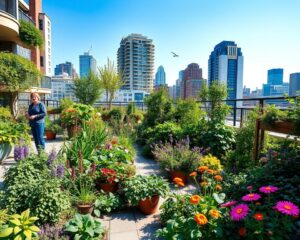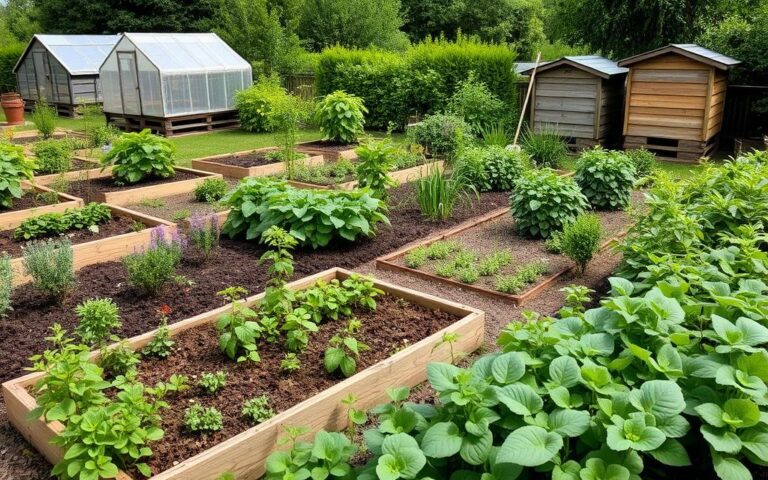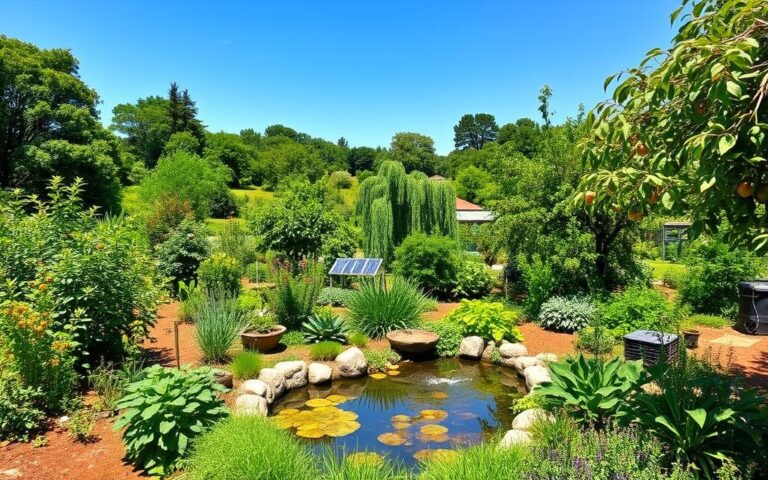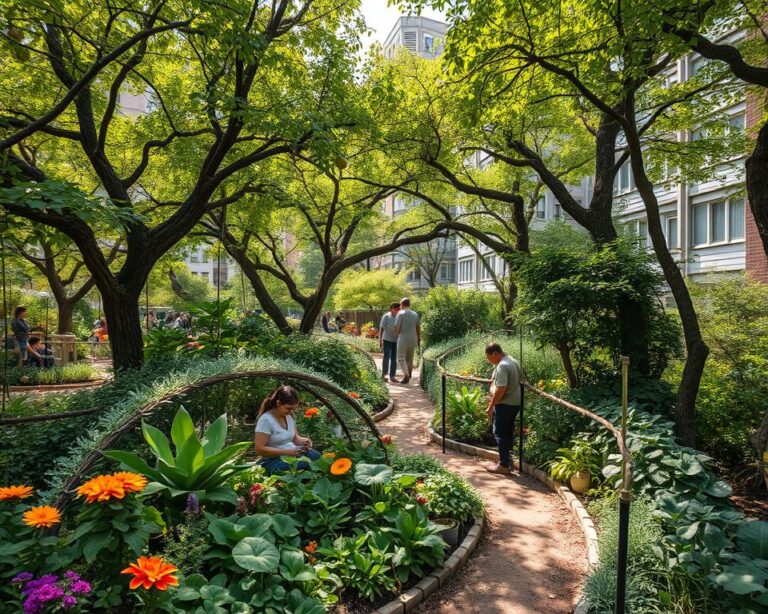Did you know that over 55% of the world’s people live in cities now? This number is expected to jump to 68% by 2050. Cities are big contributors to pollution, with about 70% of global carbon dioxide emissions coming from them. This makes it crucial to make cities greener.
Urban Permaculture is a way to bring biodiversity to even the smallest areas. It’s a method that can turn your backyard, balcony, or patio into a lush, productive space. Not only will you grow your own food, but you’ll also improve the air and your life.
Even tiny areas can support a wide variety of plants and animals. This article will show you how to garden in small spaces. You’ll learn how to make a big difference in your city.
What is Urban Permaculture?
Urban permaculture is about using permaculture in cities. It turns small areas into lively ecosystems. It helps people grow their own food in a way that’s good for the planet.
It’s about making the most of our limited space in cities. This way, we can live more sustainably.
Definition and Principles
Urban permaculture brings sustainable gardening to city life. It makes gardens that are not just pretty but also work well. They help bring back biodiversity.
It’s different from traditional gardening, which often focuses on looks or growing just one type of plant. Urban permaculture encourages growing native plants. This creates spaces that support many types of life and need less care.
Key Differences from Traditional Gardening
Traditional gardening often focuses on looks and big lawns. But urban permaculture sees gardening in a different way. Here are some main differences:
- Focus on Biodiversity: Urban permaculture aims to grow many different plants to keep ecosystems balanced.
- Resource Efficiency: It uses methods that don’t need lots of chemicals or pesticides.
- Community Engagement: It brings people together, encouraging them to share and work together.
In cities, where rules and norms might make it hard to garden, urban permaculture offers a new way. It can change how we see our surroundings. It makes our urban spaces not just places to live but also thriving parts of nature.
Importance of Biodiversity in Urban Settings
Biodiversity is key in cities, shaping local ecosystems. As cities grow, many species lose their homes. This creates big challenges for keeping nature in balance.
Benefits for Local Ecosystems
Diverse plants help local ecosystems thrive, providing homes for wildlife. Urban farms help by bringing back lost habitats. They attract good insects and birds that keep pests away.
This boosts the city’s ability to handle environmental stress. Cities with many plant species keep more native life, even with urban problems.
Enhancing Food Security
Urban farming is crucial for food security in crowded cities. Growing your own food cuts down on relying on others. It tackles food access and supports green living.
Having a variety of edible plants improves nutrition and saves money. Working together in the community makes urban farming stronger. It builds a sense of food freedom and security.
| Aspect | Impact of Biodiversity | Urban Farming Benefits |
|---|---|---|
| Local Ecosystems | Supports wildlife, pest control, and pollination | Enhances food varieties and reduces dependence on external sources |
| Resilience | Strengthens ecosystem stability against climate change | Promotes sustainable practices in urban settings |
| Food Security | Ensures access to diverse food sources | Encourages local production and self-sufficiency |
Designing Your Urban Permaculture Garden
Starting your urban permaculture garden is exciting. First, think about the space you have. Look at sunlight, soil, and microclimates. Even small spaces can be turned into green oases.
Assessing Available Space
Knowing your space is key for a green garden. You can use permaculture zones in any size space. Check these things:
- Sunlight Availability: Find out where the sun hits and where it’s shaded.
- Soil Quality: Test your soil and add compost to make it better.
- Microclimates: Look for spots with different temperatures and moisture.
Choosing the Right Plants
Choosing the right plants is crucial. Pick native and drought-tolerant ones for less work and more wildlife. Think about a food forest or fruit trees in public areas. Here’s a list of good plants for your garden:
| Plant Type | Benefits | Ideal Conditions |
|---|---|---|
| Herbs (e.g., basil, mint) | Attract pollinators, culinary use | Full sun, well-drained soil |
| Native Shrubs (e.g., elderberry, serviceberry) | Support local wildlife, edible fruits | Varied moisture conditions |
| Drought-Resistant Plants (e.g., lavender, succulents) | Low water requirements, easy care | Well-drained, sunny spots |
| Vegetables (e.g., tomatoes, peppers) | Food production, diversity | Full sun, rich soil |
By choosing the right plants and following these tips, your garden will flourish. It will meet your needs and help your local ecosystem.
Implementing Vertical Gardening Techniques
Adding vertical gardening to your urban space is a smart move. It helps you use every inch of space and boosts biodiversity. You can turn walls and fences into lush green spots. This makes your area look better and supports sustainable living.
Benefits of Vertical Gardens
Vertical gardens bring many benefits to your garden and the environment. Some key advantages include:
- Maximizing limited ground space by utilizing vertical surfaces.
- Improving air quality as plants filter pollutants and produce oxygen.
- Providing habitats for beneficial insects and wildlife, promoting biodiversity.
- Encouraging sustainable practices through increased food production.
In cities, where space is tight, vertical gardens let you grow more. Bill Mollison noted that cities like New York have high food costs. Vertical gardening helps by increasing local food production.
Popular Vertical Plant Choices
Picking the right plants is key for a great vertical garden. Here are some top picks that do well in these setups:
| Plant | Growth Characteristics | Benefits |
|---|---|---|
| Passion Fruit Vines | Grow up to 30 feet in a year | Year-round blooms and delicious fruit |
| Herbs (Basil, Mint) | Compact growth | Enhance flavor and culinary creativity |
| Flowering Vines (Morning Glories) | Fast-growing and vibrant colors | Attract pollinators and improve aesthetics |
Choosing plants that fit your space and taste helps your local ecosystem and your health. Vertical gardening makes your urban garden better and supports a greener planet.
Incorporating Edible Plants into Your Landscape
Adding edible plants to your landscape makes it both beautiful and useful. You can pick fresh food right from your garden. Start by picking a mix of edible flowers and herbs that fit your garden’s look.
Choosing Edible Flowers and Herbs
Edible flowers like nasturtiums and calendulas bring color and attract helpful bugs. Herbs like basil, mint, and chives are tasty and pretty. Adding these plants boosts your garden’s health and looks.
Companion Planting Strategies
Companion planting means putting plants together for a healthy garden. It makes plants grow better and keeps pests away. For example, garlic near roses keeps aphids off, and beans help nearby plants grow.
Using these methods, you can use your space well. You’ll enjoy fresh food and help urban farming grow.
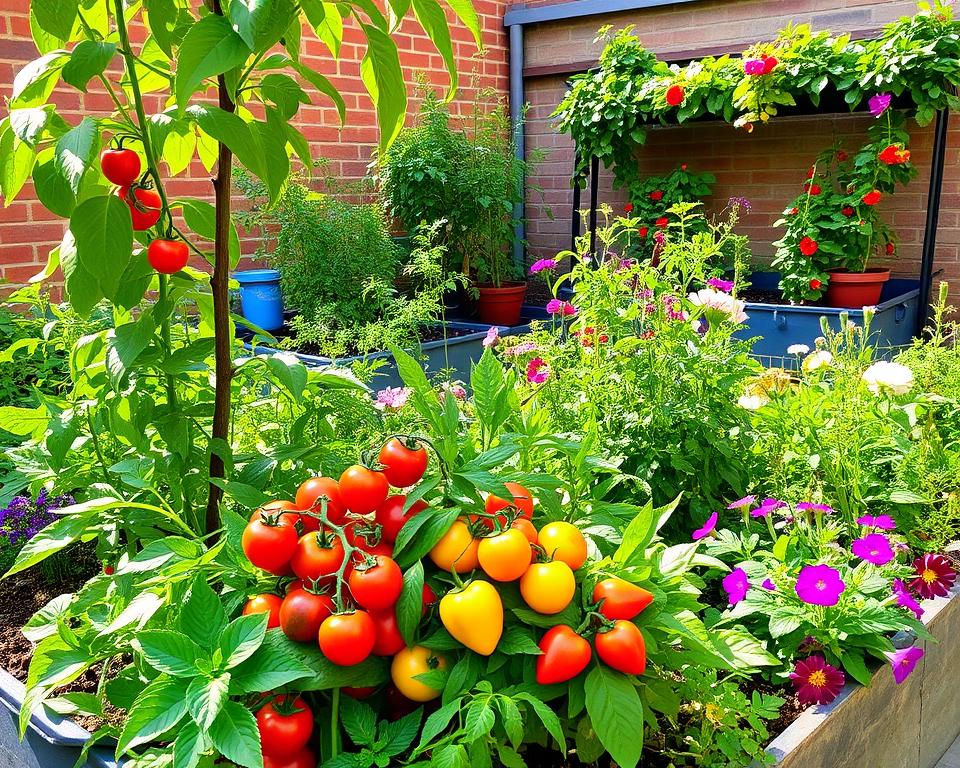
Utilizing Sustainable Practices
Sustainable gardening is key for a healthy urban environment. Using rainwater and composting cuts down on waste. It also makes soil better and helps plants grow. These actions make your garden strong and green.
Rainwater Harvesting and Composting
Starting a rainwater system is a big step for city gardeners. It lets you use rainwater when it’s dry. This saves water and lessens urban runoff.
Composting is also vital. It turns kitchen and yard waste into soil food. This makes plants healthier and cuts down landfill waste.
Natural Pest Control Methods
Using natural pest control means less chemical use. Ladybugs can fight aphids, and row covers protect plants. These methods keep your garden safe and healthy for plants and animals.
| Practice | Description | Benefits |
|---|---|---|
| Rainwater Harvesting | Collecting and storing rainwater for irrigation. | Saves water costs, reduces runoff, promotes conservation. |
| Composting | Converting organic waste into nutrient-rich soil amendments. | Improves soil health, reduces waste, supports plant growth. |
| Organic Pest Control | Utilizing natural methods to deter pests without chemicals. | Protects beneficial insects, reduces chemical usage, enhances biodiversity. |
Creating Microclimates in Small Spaces
Creating successful microclimates in your urban garden boosts plant health and productivity. Knowing how to use sun and shade is key to thriving ecosystems in small areas. By understanding your environment, you can place plants in their best spots.
How to Utilize Sun and Shade
Good urban gardening design starts with knowing sun and shade areas. Shade plants go where light is scarce, and sun lovers get the bright spots. Surrounding structures can make areas warmer, letting more plants grow.
Watching the sun’s path helps find the best spots for your plants. This maximizes their growth.
Windbreaks and Heat Traps
Windbreaks are crucial for good microclimates. They can be hedges or fences that shield plants from strong winds. Heat traps like stone walls or raised beds keep warmth, extending the growing season.
Choose materials that soak up sunlight and release it at night. This helps create a balanced microclimate.
Engaging Your Community with Urban Permaculture
Getting involved in urban permaculture lets people connect and work together in their neighborhoods. By setting up events like permaculture workshops or community gardens, you help people learn about sustainability. This builds strong bonds within the community.
This teamwork not only helps everyone work together but also boosts urban sustainability efforts.
Organizing Workshops and Events
Workshops are a great way for community members to learn about permaculture and sustainable living. These gatherings are where people share knowledge and resources. This helps the community grow stronger through gardening projects.
Some activities that can help include:
- Hands-on permaculture workshops to teach basic gardening skills.
- Community events focusing on composting and water management techniques.
- Gathering sessions to brainstorm ideas for new community gardens.
Sharing Resources and Knowledge
Creating a space for people to interact can change a neighborhood for the better. Sharing tools and seeds is key to successful community gardens. By using permaculture, neighborhoods can become thriving ecosystems.
Here’s a strategy to make it happen:
| Resource | Shared Use | Benefits |
|---|---|---|
| Gardening Tools | Tool Libraries | Reduces costs and encourages shared learning |
| Seeds | Seed Exchanges | Greater variety and support for biodiversity |
| Knowledge | Workshops and Meet-Ups | Empowers community members with skills and confidence |
The Role of Wildlife in Urban Permaculture
Adding wildlife to urban permaculture systems boosts both garden productivity and ecological balance. By focusing on wildlife habitats, we create gardens that attract vital species. Designing your garden to welcome beneficial insects and pollinators is key to maintaining healthy urban ecosystems.
Attracting Beneficial Insects and Pollinators
To support thriving wildlife habitats, plant a variety of native species. These plants help local insects like bees and butterflies, which are crucial pollinators. These insects not only boost your garden’s productivity but also help stabilize urban ecosystems. Adding features like insect hotels or diverse flowering plants can attract more beneficial insects.
Creating Habitats for Urban Fauna
Building small wildlife habitats in your garden can greatly boost local biodiversity. Features like bird feeders, water sources, and brush piles offer shelter and resources for urban wildlife. Your garden can become a safe haven for various species, even in the midst of urban growth. Using holistic design ensures wildlife and gardening can coexist, making the urban landscape richer.
| Wildlife Feature | Benefits | Recommended Plant Types |
|---|---|---|
| Pollinator Gardens | Increases pollination rates | Lavender, Coneflower, Milkweed |
| Bird Feeders | Attracts various bird species | Sunflower, Nyjer, Safflower seeds |
| Insect Hotels | Provides habitats for beneficial insects | Deadwood, Straw, Bamboo |
| Water Features | Offers hydration for wildlife | Native aquatic plants, Lotus, Water lilies |
By working to promote wildlife habitats, we help create balanced urban ecosystems. These ecosystems thrive from the complex relationships between plants and animals. Your efforts towards wildlife-friendly practices enrich the urban environment for all species.
Tools and Resources for Urban Permaculture
Starting your urban permaculture journey requires the right tools and resources. Essential gardening tools like hand trowels, compost bins, and rain barrels are key. They help you make the most of your space and ensure your garden thrives.
Essential Gardening Tools
Quality gardening tools can greatly improve your gardening experience. There are tools for container gardening, raised beds, and even rooftop gardens. They come in materials like plastic, terracotta, and fabric, each with its own benefits.
Using tools like drip irrigation can make gardening easier and more productive. This helps you get the most out of your space.
Books and Online Platforms to Explore
There are many educational materials available. Toby Hemenway’s book, Gaia’s Garden: A Guide to Home-Scale Permaculture, is a great starting point. Online platforms also offer courses on topics like rainwater harvesting and composting for urban areas.
By diving into these resources, you’ll learn more about urban permaculture. You’ll also connect with local communities. This allows you to share your experiences and gain new insights.

